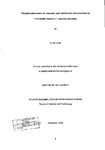TRANSFORMATIONS OF ORGANIC AND INORGANIC PHOSPHORUS IN ESTUARINE PARTICLE- WATER SYSTEMS
| dc.contributor.author | Zhao, Jin Bo | |
| dc.contributor.other | School of Geography, Earth and Environmental Sciences | en_US |
| dc.date.accessioned | 2013-09-17T11:22:22Z | |
| dc.date.available | 2013-09-17T11:22:22Z | |
| dc.date.issued | 2009 | |
| dc.identifier | NOT AVAILABLE | en_US |
| dc.identifier.uri | http://hdl.handle.net/10026.1/1791 | |
| dc.description.abstract |
This thesis describes methodologies to detemiine organic and inorganic phosphorus in water and discusses biological, physical and chemical controls on the transformations of organic and inorganic phosphorus in laboratory microcosms of estuarine particle-water systems. Phosphorus is an important nutrient and the accurate determination of phosphorus species in natural waters is essential for understanding the biogeochemical cycling of the element. Chapter one reviews phosphorus impacts on water quality and relevant UK legislation, the sources, speclation and fractionation of phosphorus, the sediment/water phosphorus cycle and analytical methods for the determination of dissolved Inorganic phosphorus (DIP) and organic phosphorus (DOP) species In natural waters. Chapter two introduces the technique of segmented flow analysis and describes methods for the determination of inorganic phosphorus and total dissolved phosphorus after autoclaving. Segmented flow analysis is suitable for determining inorganic P and organic P species in freshwaters in the range of 1 - 300 pg P L"\ Calibrations were linear (R^ > 0.997) over the range 0.5 - 100 pg P L'^ with good precision (RSDs < 3 %). The LCD was 0.4 pg P L'^ for DIP and 3 pg P L'^ for DOP. The recoveries of 7 model organic phosphorus compounds (adenosine-5-triphosphate di-sodium salt (ATP), phytic acid (PTA), sodium tripolyphosphate (STP), methyltriphenylphosphonium bromide (MPT), p-nitrophenyl phosphate magnesium salt (p-NPP), p-D-glucose-6-phosphate monosodium salt (G-6-P) and cocartjoxylase (COCA)) were all > 90 %. Chapter three reports on bacterial uptake studies of phosphorus species in a plug-flow microcosm. Experiments using inert Duran and Siran beads as supports for bacterial bioflim development showed similar P uptake behaviour. Glucose-6-phosphate was almost fully utilised and converted to DIP after 3 days suggesting that labile organic phosphorus species could be a bioavailable source of P for bacteria. Phytic acid (a refractory P compound) released significant concentrations of DIP to the water column due to physical displacement. Chapter four describes phosphonjs transformations in a sediment-water flume due to turbulent resuspension events. The released DIP concentration had a strong linear relationship with shear stress in pure water and artiflcial seawater. However, no signtflcant relationship between DOP release and shear stress was observed. The sediment type and the water matrix significantly affected the magnitude of DIP and DOP release to the water column. Chapter flve extends the investigation of P exchange to constant resuspension events. The water matrix had a significant effect on the rate of DIP and DOP release from sediment and the sedimentAvaler equilibration time. Typically 6 - 12 % of total phosphorus in the sediment was released as DIP and DOP into the water column. When orthophosphate and phytic acid were added to both UHP and river water. SPM was able to buiffer theses additions. However, the SPM buffering capacity was much lower for G-6-P. The buffering capacity of the SPM for phytic acid was significant and permanent in UHP and biotic river water, whereas phytic acid was cycled in the abiotic experiments. | en_US |
| dc.language.iso | en | en_US |
| dc.publisher | University of Plymouth | en_US |
| dc.title | TRANSFORMATIONS OF ORGANIC AND INORGANIC PHOSPHORUS IN ESTUARINE PARTICLE- WATER SYSTEMS | en_US |
| dc.type | Thesis | |
| plymouth.version | Full version | en_US |
| dc.identifier.doi | http://dx.doi.org/10.24382/4257 |
Files in this item
This item appears in the following Collection(s)
-
01 Research Theses Main Collection
Research Theses Main


